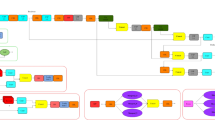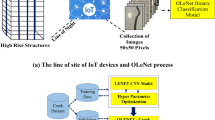Abstract
Cracks are one of the forms of damage to concrete structures that debase the strength and durability of the building material and may pose a danger to the living being associated with it. Proper and regular diagnosis of concrete cracks is therefore necessary. Nowadays, for the more accurate identification and classification of cracks, various automated crack detection techniques are employed over a manual human inspection. Convolution Neural Network (CNN) has shown excellent performance in image processing. Thus, it is becoming the mainstream choice to replace the manual crack classification techniques, but this technique requires huge labeled data for training. Transfer learning is a strategy that tackles this issue by using pre-trained models. This work first time strives to classify concrete surface cracks by re-training of six pre-trained deep CNN models such as VGG-16, DenseNet-121, Inception-v3, ResNet-50, Xception, and InceptionResNet-v2 using transfer learning and comparing them with different metrics, such as Accuracy, Precision, Recall, F1-Score, Cohen Kappa, ROC AUC, and Error Rate in order to find the model with the best suitability. A dataset from two separate sources is considered for the re-training of pre-trained models, for the classification of cracks on concrete surfaces. Initially, the selective crack and non-crack images of the Mendeley dataset are considered, and later, a new dataset is used. As a result, the re-trained classifier of CNN models provides a consistent performance with an accuracy range of 0.95 to 0.99 on the first dataset and 0.85 to 0.98 on the new dataset. The results show that these CNN variants can produce the best outcome when finding cracks in the real situation and have strong generalization capabilities.










Similar content being viewed by others
Data availability
References
Athanasiou A, Ebrahimkhanlou A, Zaborac J, Hrynyk T, Salamone S (2020) A machine learning approach based on multifractal features for crack assessment of reinforced concrete shells. Comput Civ Infrastruct Eng 35(6):565–578. https://doi.org/10.1111/mice.12509
Brownlee J (2019) How to Manually Scale Image Pixel Data for Deep Learning, Machine Learning Mastery https://machinelearningmastery.com/how-to-manually-scale-image-pixel-data-for-deep-learning/#:~:text=Pixel.values are often unsigned,expected training of the model
Cho S, Kim B, Kim G (2019) Application of deep learning-based crack assessment technique to civil structures, Fifth conference on Smart Monitoring, Assessment and Rehabilitation of Civil Structures (SMAR-2019), pp. 1–8
Christian Koch PF, Georgieva K, Kasireddy V, Akinci B (2015) A review on computer vision based defect detection and condition assessment of concrete and asphalt civil infrastructure. Adv Eng Inform 29(2):196–210. https://doi.org/10.1016/j.aei.2015.01.008
de Lucena DS, da Silva WRL (2018) “Concrete cracks detection based on deep learning image classification,” MDPI Proc, https://doi.org/10.3390/ICEM18-05387
Developers S-L (2020) Metrics and scoring: quantifying the quality of predictions,” Scikit Learn, https://scikit-learn.org/stable/modules/model_evaluation.html#classification-metrics
Dorafshan S, Thomas RJ, Maguire M (2018) Comparison of deep convolutional neural networks and edge detectors for image-based crack detection in concrete. Constr Build Mater 186:1031–1045. https://doi.org/10.1016/j.conbuildmat.2018.08.011
Dung CV, Anh LD (2019) Autonomous concrete crack detection using deep fully convolutional neural network. Autom Constr 99:52–58. https://doi.org/10.1016/j.autcon.2018.11.028
Gao Y, Mosalam KM (2018) Deep transfer learning for image-based structural damage recognition. Comput Civ Infrastruct Eng 33(9):748–768. https://doi.org/10.1111/mice.12363
Hoang N-D (2018) Image processing-based recognition of wall defects using machine learning approaches and steerable filters. Comput Intell Neurosci 2018:1–18. https://doi.org/10.1155/2018/7913952
Huang H, Li Q, Zhang D (2018) Deep learning based image recognition for crack and leakage defects of metro shield tunnel. Tunn Undergr Sp Technol 77:166–176. https://doi.org/10.1016/j.tust.2018.04.002
Islam MMM, Kim J-M (2019) Vision-based autonomous crack detection of concrete structures using a fully convolutional encoder–decoder network. Sensors 19:1–12. https://doi.org/10.3390/s19194251
Jung NLWM, Naveed F, Hu B, Wang J (2019) Exploitation of deep learning in the automatic detection of cracks on paved roads, Geomatica
Kim B, Cho S (2018) Automated Vision-Based Detection of Cracks on Concrete Surfaces Using a Deep Learning Technique. Sensors 18(10):3452. https://doi.org/10.3390/s18103452
Kim A-R, Byun Y-S, Chun C, Kim D, Lee S-W (2019) Automated concrete crack detection and using deep leaning and image processing method, Adv Struct Eng Mech
Kim H, Ahn E, Shin M, Sim S-H (2019) Crack and noncrack classification from concrete surface images using machine learning. Struct Health Monit 18(3):725–738. https://doi.org/10.1177/1475921718768747
Li S, Zhao X (2019) Image-based concrete crack detection using convolutional neural network and exhaustive search technique. Adv Civ Eng 2019:1–12. https://doi.org/10.1155/2019/6520620
Liu H, Zhang Y (2019) Image-driven structural steel damage condition assessment method using deep learning algorithm. Measurement 133:168–181. https://doi.org/10.1016/j.measurement.2018.09.081
Moon H-G, Kim J-H (2011) Inteligent Crack Detecting Algorithm on the Concrete Crack Image Using Neural Network, in 28th International Symposium on Automation and Robotics in Construction, pp. 1461–1467. https://doi.org/10.22260/ISARC2011/0279
Özgenel ÇF, Sorguç AG (2018) Performance comparison of pretrained convolutional neural networks on crack detection in buildings. In: Proceedings of the International Symposium on Automation and Robotics in Construction (IAARC). https://doi.org/10.22260/isarc2018/0094
Pan SJ, Yang Q (2010) A survey on transfer learning. IEEE Trans Knowl Data Eng 22(10):1345–1359. https://doi.org/10.1007/978-981-15-5971-6_83
Perez H, Tah JHM, Mosavi A (2019) Deep Learning for Detecting Building Defects Using Convolutional Neural Networks. Sensors 19(16):3556. https://doi.org/10.3390/s19163556
Qian Y et al. (2019) Fresh Tea Leaves Classification Using Inception-V3, 2019 2nd IEEE Int. Conf Inf Commun Signal Process ICICSP 2019, pp. 415–419, https://doi.org/10.1109/ICICSP48821.2019.8958529.
Qu Z, Chen Y-X, Liu L, Xie Y, Zhou Q (2019) The algorithm of concrete surface crack detection based on the genetic programming and percolation model. IEEE Access 7:57592–57603. https://doi.org/10.1109/ACCESS.2019.2914259
Raj APSS, Vajravelu SK (2019) DDLA: dual deep learning architecture for classification of plant species. IET Image Process 13(12):2176–2182. https://doi.org/10.1049/iet-ipr.2019.0346
Rajeshwari M, Rathika K (2018) Detection of roof holes and wall crack using shape-based method. SSRG Int J Comput Sci Eng 5(5):6–10. https://doi.org/10.14445/23488387/IJCSE-V5I5P102
Sagar RV (2019) Support vector machine procedure and Gaussian mixture modelling of acoustic emission signals to study crack classification in reinforced concrete structures
Shao L, Zhu F, Li X (2015) Transfer learning for visual categorization: a survey. IEEE Trans Neural Networks Learn Syst 26(5):1019–1034. https://doi.org/10.1109/TNNLS.2014.2330900
Shi C, Xia R, Wang L (2020) A novel multi-Branch Channel expansion network for garbage image classification. IEEE Access 8:154436–154452. https://doi.org/10.1109/ACCESS.2020.3016116
Simler C, Trostmann E, Berndt D (2019) Automatic crack detection on concrete floor images, in Photonics and Education in Measurement Science 2019, p. 41. https://doi.org/10.1117/12.2531951.
Sitara RGS, Kavitha NS (2018) Review and analysis of crack detection and classification techniques based on crack types. Int J Appl Eng Res 13(8):6056–6062
Słoński M (2019) A comparison of deep convolutional neural networksfor image-based detection of concrete surface cracks. Comput Assist Methods Eng Sci 26:105–112. https://doi.org/10.24423/cames.267
Wang S, Yang F, Cheng Y, Yang Y, Wang Y (2018) Adaboost-based Crack Detection Method for Pavement. IOP Conf Ser: Earth Environ Sci 189:022005. https://doi.org/10.1088/1755-1315/189/2/022005
Wang B, Li Y, Zhao W, Zhang Z, Zhang Y, Wang Z (2019) Effective Crack Damage Detection Using Multilayer Sparse Feature Representation and Incremental Extreme Learning Machine. Appl Sci 9(3):614. https://doi.org/10.3390/app9030614
Wu X, Xu H, Wei X, Wu Q, Zhang W, Han X (2020) Damage identification of low emissivity coating based on convolution neural network. IEEE Access 8:156792–156800. https://doi.org/10.1109/ACCESS.2020.3019484
Xia X, Xu C, Nan B (2017) “Inception-v3 for flower classification,” 2017 2nd Int. Conf. Image, Vis. Comput. ICIVC 2017, pp. 783–787, https://doi.org/10.1109/ICIVC.2017.7984661.
Xu H, Su X, Wang Y, Cai H, Cui K, Chen X (2019) Automatic Bridge Crack Detection Using a Convolutional Neural Network. Appl Sci 9(14):2867. https://doi.org/10.3390/app9142867
Xu G, Shen X, Chen S, Zong Y, Zhang C, Yue H, Liu M, Chen F, Che W (2019) A deep transfer convolutional neural network framework for EEG signal classification. IEEE Access 7:112767–112776. https://doi.org/10.1109/access.2019.2930958
Zhang L, Yang F, Daniel Zhang Y, Zhu YJ (2016) Road crack detection using deep convolutional neural network, in 2016 IEEE International Conference on Image Processing (ICIP), pp. 3708–3712. https://doi.org/10.1109/ICIP.2016.7533052.
Zhang K, Zhang Y, Cheng H-D (2019) CrackGAN: pavement crack detection using partially accurate ground truths based on generative adversarial learning, IEEE Trans Intell Transp Syst, https://doi.org/10.1109/TITS.2020.2990703
Zhang J, Lu C, Wang J, Wang L, Yue X-G (2019) Concrete Cracks Detection Based on FCN with Dilated Convolution. Appl Sci 9(13):2686. https://doi.org/10.3390/app9132686
Zhu J, Zhang C, Qi H, Lu Z (2020) Vision-based defects detection for bridges using transfer learning and convolutional neural networks. Struct Infrastruct Eng 16(7):1037–1049. https://doi.org/10.1080/15732479.2019.1680709
Acknowledgements
The work of Prashant Kumar was supported in part by the All India Council of Technical Education, New Delhi, India, and in part by the Indian National Academy of Engineering (INAE), Gurgaon, India.
Funding
This project does not have any funding.
Author information
Authors and Affiliations
Corresponding author
Ethics declarations
Conflict of interest
The authors declare that they have no conflict of interest.
Additional information
Publisher’s note
Springer Nature remains neutral with regard to jurisdictional claims in published maps and institutional affiliations.
Rights and permissions
Springer Nature or its licensor (e.g. a society or other partner) holds exclusive rights to this article under a publishing agreement with the author(s) or other rightsholder(s); author self-archiving of the accepted manuscript version of this article is solely governed by the terms of such publishing agreement and applicable law.
About this article
Cite this article
Kumar, P., Purohit, G., Tanwar, P.K. et al. Feasibility analysis of convolution neural network models for classification of concrete cracks in Smart City structures. Multimed Tools Appl 82, 38249–38274 (2023). https://doi.org/10.1007/s11042-023-15136-z
Received:
Revised:
Accepted:
Published:
Issue Date:
DOI: https://doi.org/10.1007/s11042-023-15136-z




